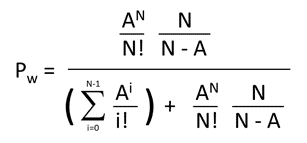Workforce Management Featured Article
Workforce Management Software Eliminates the Need for Erlang-C

If you manage a call center and you’re of a certain age, chances are that you know how to calculate the Erlang-C formula, a mathematical calculation that allows call center managers to calculate the number of staff needed for a given number of calls, to meet a given service level. It’s a way to put mathematical numbers to a queuing system in which calls arrive, wait in a virtual line, and are then serviced by an agent.
On paper, it looks something like this:

Traditionally, call center managers have built Excel spreadsheets to include the formula, allowing them to make the calculation to determine the optimum staffing level. There are, however, some problems with relying on Erlang-C alone.
It’s time consuming. Even if you’re good with the math, it still takes time to create the Excel spreadsheet and run your numbers though it regularly. That’s time that could be spent managing.
It’s not flexible. It assumes a steady rate of call arrival, which is seldom the case. It also assumes that you’ll have no abandoned calls or busy signals, and that you will have a fixed number of staff handling calls throughout the time period. In real life, this is seldom the case.
It doesn’t take human nature into account. Erlang-C assumes all callers will be prepared to wait as long as necessary for service without hanging up. In reality, callers are willing to wait just minutes on hold before they hang up.
While there are mathematical ways to account for things like absenteeism, shrinkage, abandoned calls and humans hanging up, the process becomes even more complex. This is why more contact centers are relying on workforce management software to do the math for them.
How Workforce Management Software Helps
Many modern workforce management platforms already have the math “built in,” so managers are free to explore various staffing scenarios to find the “sweet spot” where customer experience and cost-efficiency meet, according to a recent blog post by Verint Monet Software (News - Alert). This can help optimize the contact center budget in ways not possible without such a technology solution.
“Bringing accurate forecasts of call volumes, handle times and occupancy and shrinkage rates into the budget alongside other costs, such as capital needs and real estate expenses, provides the full picture of the contact center’s resource needs,” according to Monet.
How Artificial Intelligence Can Help
The more communications media there are, the more complex the contact center gets. Add to this high customer expectations, and doing the minimum job necessary for call center forecasting using manual methods and spreadsheets becomes impossible.
But while the human brain may not be up to it, the artificial intelligence (AI) brain is. Many of today’s modern cloud-based workforce management solutions are built on a framework of AI, which means they can make more precise calculations and predictions using all available data, according to the Monet blog.
“With workforce management software, seamless integration of mounds of historical data results in highly refined predictions,” according to the blog. “And a user-friendly interface slashes the time required to manage employee scheduling while alleviating the need to consider Erlang formulas—and thank goodness for that!”
Edited by Maurice Nagle







